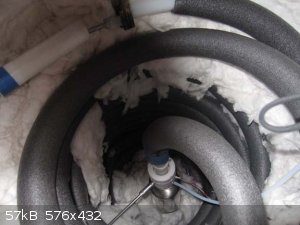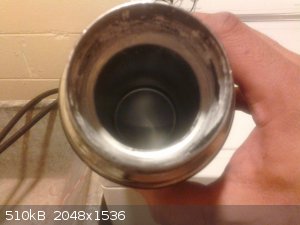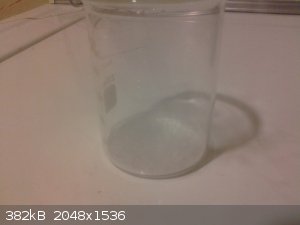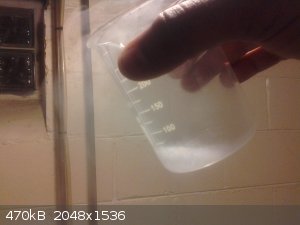| Pages:
1
2 |
Gearhead_Shem_Tov
Hazard to Others
  
Posts: 167
Registered: 22-8-2008
Location: Adelaide, South Australia
Member Is Offline
Mood: No Mood
|
|
Liquid Nitrogen generator
I came across this on Instructables today:
Home Made Liquid Nitrogen Generator
Enjoy.
-Bobby
[Edited on 29-12-2014 by Gearhead_Shem_Tov]
|
|
|
neptunium
National Hazard
   
Posts: 985
Registered: 12-12-2011
Location: between Uranium and Plutonium
Member Is Offline
|
|
have you seen this?
https://www.youtube.com/watch?v=4_bGkztd7t0
and that
https://www.youtube.com/watch?v=51a7X7lblMc
|
|
|
Bert
Super Administrator
        
Posts: 2821
Registered: 12-3-2004
Member Is Offline
Mood: " I think we are all going to die. I think that love is an illusion. We are flawed, my darling".
|
|
That's going to make amateur rocketry a lot more fun...
Rapopart’s Rules for critical commentary:
1. Attempt to re-express your target’s position so clearly, vividly and fairly that your target says: “Thanks, I wish I’d thought of putting it
that way.”
2. List any points of agreement (especially if they are not matters of general or widespread agreement).
3. Mention anything you have learned from your target.
4. Only then are you permitted to say so much as a word of rebuttal or criticism.
Anatol Rapoport was a Russian-born American mathematical psychologist (1911-2007).
|
|
|
forgottenpassword
Hazard to Others
  
Posts: 374
Registered: 12-12-2013
Member Is Offline
Mood: No Mood
|
|
Very interesting. Being able to make liquid nitrogen on demand would meet any cooling requirements that a chemist could possibly have, I should think!
Personally I'd be more interested in buying one than making one. The fellow mentions making and selling them for $150, but whether he's made any to
sell or not I have no idea. I wonder if there are any EXISTING commercial coolers that meet the same requirement of condensing nitrogen, that anyone
is aware of? Hopefully more compact, too. Perhaps these are common in smaller laboratories? If not, they certainly should be! I've got all the parts
together to make a Sprengel vacuum pump, so a source of liquid nitrogen could come in useful!
[Edited on 29-12-2014 by forgottenpassword]
|
|
|
careysub
International Hazard
    
Posts: 1339
Registered: 4-8-2014
Location: Coastal Sage Scrub Biome
Member Is Offline
Mood: Lowest quantum state
|
|
I'm believe that the $150 product he references (if he does follow through) would be a kit-to-build kind of thing, certainly not with the compressor.
Here is also an NIST document about this technology for laboratory scale:
[Edited on 29-12-2014 by careysub]
Attachment: nbsscientificpaper419vol17p277_A2b.pdf (578kB)
This file has been downloaded 592 times
|
|
|
j_sum1
Administrator
       
Posts: 6218
Registered: 4-10-2014
Location: Unmoved
Member Is Offline
Mood: Organised
|
|
Liquid air is not liquid nitrogen. Removal of the O2 is not insurmountable and may not be needed for some applications. However the tendency for
oxygen to concentrate as the air evaporates presents a significant hazard.
|
|
|
forgottenpassword
Hazard to Others
  
Posts: 374
Registered: 12-12-2013
Member Is Offline
Mood: No Mood
|
|
Interesting, thanks!
What do
you suggest practically doing about it?
Or are you just the person that says: "There is a significant hazard. I urge caution."
[Edited on 29-12-2014 by forgottenpassword]
|
|
|
HgDinis25
Hazard to Others
  
Posts: 439
Registered: 14-3-2014
Location: Portugal
Member Is Offline
Mood: Who drank my mercury?
|
|
Interesting, I'm planing to make a liquid air generator in a few days... And now I have one more topic filled with intel 
http://gizmology.net/liquid_air.htm
What I plan to make is an adaptation of Carl von Linde's machine. I was able to get my hands on a fridge compressor and a dehumidifier compressor.
The theory is simples. When you take a pressurized gas and make it pass through a small opening, it decompresses and loses energy. The links posted
above already explain this. However, when you compress a gas, its temperature increases.
I plan to put the two compressors inside an isolated box. The first one takes air from said box and compresses it through a tube going to a second
isolated box (the collection vessel). There it passes through a small opening, decompresses, and loses energy. This box is conected to the first box
through another tube. And the cycle repeats again.
So, air goes to the compressor, passes through small opening to the second box, returns to the first box and is compressed again.
Now, what about the second compressor, in the first box? That one is only going to compress air and pass it through a small opening INSIDE the first
box. That way the increasing of temperature derived from both compressors working is compensated by the second compressor, while the first compressor
makes the gas go to the second box.
I don't know if I'll be able to get this working or not. Even if it works, dry ice clogging the tubes will probably be a problem. Also, the boxes I
mentioned need to have valves. One to allow more air to enter, should any gas condense, and other to remove said condensed gas.
|
|
|
Dr.Bob
International Hazard
    
Posts: 2656
Registered: 26-1-2011
Location: USA - NC
Member Is Offline
Mood: No Mood
|
|
That is a pretty interesting concept to make LN2 at home. I barely even use it at work now, mostly use dry ice a lot, but LN2 is very useful. And
the LOX can be even more useful, especially for starting your charcoal fire, as I am sure many of you have seen. (if not, google "George LOX
charcoal fire" or something like that.) I am always impressed by some of the home made apparatus I have seen made over the years. My favorite was
a Van de Graf generator someone here made a few years back and was big enough to create quite a lightning storm.
Even the "professional" fluorination apparatus that I saw when I worked in a fluorochem lab was pretty much hand made and looked as much as something
from an autoshop as from a chemical engineering lab. I think it was either Monel or some other nickel alloy, which might be a little pricey. I
still have a nice piece of Monel pipe that is likely worth a lot as scrap if I could find a buyer. I used it as part of a pile driver type weight for
a while before I knew what it was made from.
|
|
|
Bert
Super Administrator
        
Posts: 2821
Registered: 12-3-2004
Member Is Offline
Mood: " I think we are all going to die. I think that love is an illusion. We are flawed, my darling".
|
|
That's not a FLAW- that's a FEATURE!
Rapopart’s Rules for critical commentary:
1. Attempt to re-express your target’s position so clearly, vividly and fairly that your target says: “Thanks, I wish I’d thought of putting it
that way.”
2. List any points of agreement (especially if they are not matters of general or widespread agreement).
3. Mention anything you have learned from your target.
4. Only then are you permitted to say so much as a word of rebuttal or criticism.
Anatol Rapoport was a Russian-born American mathematical psychologist (1911-2007).
|
|
|
careysub
International Hazard
    
Posts: 1339
Registered: 4-8-2014
Location: Coastal Sage Scrub Biome
Member Is Offline
Mood: Lowest quantum state
|
|
Quote: Originally posted by forgottenpassword  |
What do
you suggest practically doing about it?
Or are you just the person that says: "There is a significant hazard. I urge caution."
[Edited on 29-12-2014 by forgottenpassword] |
I can volunteer for that one.
Short answer: you must treat it as if it was liquid oxygen, not that inert benign material liquid nitrogen.
It starts out as 20% LOX, bad enough itself, but the concentration only increases as nitrogen evaporates.
"Liquid oxygen contains 4,000 times more oxygen by volume than normal air. Materials that are usually considered non-combustible, (such as carbon and
stainless steels, cast iron, aluminum, zinc and teflon (PTFE),) may burn in the presence of liquid oxygen. Many organic materials can react
explosively, especially if a flammable mixture is produced. Clothing splashed or soaked with liquid oxygen can remain highly flammable for hours."
http://www.ccohs.ca/oshanswers/chemicals/cryogenic/cryogen1....
|
|
|
Bert
Super Administrator
        
Posts: 2821
Registered: 12-3-2004
Member Is Offline
Mood: " I think we are all going to die. I think that love is an illusion. We are flawed, my darling".
|
|
Liquid air is not to be trifled with, despite my previous tongue in cheek comment.
Oxyliquits:
http://www.sciencemadness.org/talk/viewthread.php?tid=16174&...
Note that some of these may detonate from fuse or exposure to fire without a detonator/booster needed.
Capable of quite high VOD too:
http://m.youtube.com/watch?v=iQKkctzGGUw
Vaguely recalled annecdote has it that spilling liquid O2 or nitrogen depleted liquid air on an asphalt runway surface has led to fatal explosions
when people merely walked over the area of spill. Looking for a reference-
It is interesting to see these youtube videos at a time many areas are trying to prevent posession of various oxidizers. Access to air and electricity
will be a bit harder to control?
Rapopart’s Rules for critical commentary:
1. Attempt to re-express your target’s position so clearly, vividly and fairly that your target says: “Thanks, I wish I’d thought of putting it
that way.”
2. List any points of agreement (especially if they are not matters of general or widespread agreement).
3. Mention anything you have learned from your target.
4. Only then are you permitted to say so much as a word of rebuttal or criticism.
Anatol Rapoport was a Russian-born American mathematical psychologist (1911-2007).
|
|
|
j_sum1
Administrator
       
Posts: 6218
Registered: 4-10-2014
Location: Unmoved
Member Is Offline
Mood: Organised
|
|
Yeah. I am just recommending caution. I can visualise some amateur with not quite enough knowledge accidently concentrating to 80% O2 and then pouring
half a litre over his desk or clothes.
|
|
|
ValenceOctet
Harmless

Posts: 2
Registered: 24-10-2014
Member Is Offline
Mood: No Mood
|
|
thx for the holiday reading :-)
[Edited on 31-12-2014 by ValenceOctet]
|
|
|
careysub
International Hazard
    
Posts: 1339
Registered: 4-8-2014
Location: Coastal Sage Scrub Biome
Member Is Offline
Mood: Lowest quantum state
|
|
Here is a particularly choice excerpt, from the hazard perspective:
"One of the most serious faults of liquid oxygen explosives is the ease with which they inflame and the rapidity with which they burn, amounting
practically and in the majority of cases to their exploding from fire." (My emphasis).
And here is a NASA study of the hazard of LOX spills on asphalt (see attached).
Result of study - thick old asphalt was very sensitive to impact explosions. With a 10 kg-M impact they got explosions 100% of the time (20 test, 70%
of them violent), with a 1 kg-M (!) impact they also got explosions 100% of the time, but "only" 1 out of the 3 tests was "violent".
Also a nice section showing in detail how they blew up their test stand.
It has as an appendix an NBS (NIST) report on LOX hazards, which mentions an (unsourced) incident of explosion caused by a man walking on a
asphalt/gravel surface, and also has this useful bit of cautionary information relevant to the amateur chemist:
"Among the materials considered particularly hazardous in the presence of liquid oxygen are sulfur, hydrocarbons, alcohols, ethers, fuels of all
kinds, oils, greases, waxes, tars, asphalt, starches, sugars, soaps, powdered metals, wood, cork, paper, textiles, rope, paints, and some plastics."
Also:
"A large number of materials may be placed in liquid oxygen for a few minutes and be detonated on impact."
Attachment: 19740002978.pdf (7.3MB)
This file has been downloaded 670 times
[Edited on 31-12-2014 by careysub]
|
|
|
HgDinis25
Hazard to Others
  
Posts: 439
Registered: 14-3-2014
Location: Portugal
Member Is Offline
Mood: Who drank my mercury?
|
|
Hum, interesting...
Oxygen has a b.p. of ~-183ºC while Nitrogen has a slightly inferior b.p. of ~-196ºC. CO2 solidifies at -78ºC. Therefore, if one tries to condense
air without CO2, the first fraction that actually condenses will be the Oxygen one. At those "freezing" temperatures is there any risk of kaboom?
If so, the best method to avoid unwanted explosions would be to remove any oxygen from air prior to add the air to the machine...
|
|
|
jock88
National Hazard
   
Posts: 505
Registered: 13-12-2012
Member Is Offline
Mood: No Mood
|
|
LOX + Carbon has been used in mines as a cheap explosive for years.
One advantage is that if it did not go off it became harmless if left for a few hours for all the O to go away.
It was static sensitive.
|
|
|
imsmooth
Harmless

Posts: 12
Registered: 4-9-2012
Member Is Offline
Mood: No Mood
|
|
I guess I found this thread late. I made the liquid nitrogen generator using a compressor. Liquid air is an issue and I certainly don't want to be
near a theromos full of LOX. If you read through my site you will see that I built a PSA nitrogen generator. This cost a few hundred dollars and is
very reliable. I get 99% nitrogen out of it with one stage at about 30 L/min, maybe more.
Here is the link, which will hopefully solve the "liquid air" issue for those interested in pursuing LN2
|
|
|
careysub
International Hazard
    
Posts: 1339
Registered: 4-8-2014
Location: Coastal Sage Scrub Biome
Member Is Offline
Mood: Lowest quantum state
|
|
Quite impressive project! Thanks!
Lots of amazing amateur projects show up on this site.
Could a commercial pressure swing oxygen concentrator be reworked to produce nitrogen?
Show us the nitrogen liquifier unit you have also.
|
|
|
imsmooth
Harmless

Posts: 12
Registered: 4-9-2012
Member Is Offline
Mood: No Mood
|
|
A concentrator has to eject the waste gas in order to concentrate the other one. So, if one has an oxygen concentrator, the waste gas should be
close-to-pure nitrogen. I've measured the waste gas on my system (N2 concentrator with O2 as waste) and it is over 40% oxygen. This is what I get
from the stream coming out into the atmosphere. It is probably much purer, but I have not collected it.
The question is if the waste gas is coming out of a single tube that you can use for collection.
My project was listed above. The whole tutorial so others can copy it is right here.
Below is an image of the collection reservoir and terminal coil.
[img][/img]

[Edited on 15-3-2015 by imsmooth]
[Edited on 15-3-2015 by imsmooth]
|
|
|
neptunium
National Hazard
   
Posts: 985
Registered: 12-12-2011
Location: between Uranium and Plutonium
Member Is Offline
|
|
finally got the last piece I needed for the sterling cooler to function properly...

the blue ish color is indeed O2

this things runs on 27 volt but consume quite a bit of juice!
the cable was hot !

but it was worth it !
|
|
|
jock88
National Hazard
   
Posts: 505
Registered: 13-12-2012
Member Is Offline
Mood: No Mood
|
|
Great project. Unfortunately the heart of the system, the compressor, is going to be a bit too expensive for most here. What are its specks.
It pumps to 200 atms (about 3000 psi) What would be the flow rate at this pressure.
Will fridge pumps give this sort of pressure (assuming you have a fridge pump that has the motor SEPARATE from the compressor.
Did you have to add special cryogenic oil to the compressor and was it specially designed to work a very low temperatures.
EDIT Sorry about all the questions. On further reading of the page they are answered.
What sort of a pump did the old timers use. Oil free? Or do you just need oil free for high purity liquids gases at the output. If you could produce
'dirty' liquid gasses they you could use a simply heat exchanger (or cold exchanger if ya like!) to give you high purity liquid gasses.
J88
[Edited on 26-4-2015 by jock88]
|
|
|
Fulmen
International Hazard
    
Posts: 1693
Registered: 24-9-2005
Member Is Offline
Mood: Bored
|
|
Impressive project indeed. And the physics is quite interesting for those inclined to do the math.
One question: Rather than using a N2-concentrator, wouldn't it be possible to incorporate two throttles to separate N2 and O2?
We're not banging rocks together here. We know how to put a man back together.
|
|
|
neptunium
National Hazard
   
Posts: 985
Registered: 12-12-2011
Location: between Uranium and Plutonium
Member Is Offline
|
|
I know some people use a membrane that separate O2 and N2 from a fridge compressor
|
|
|
annaandherdad
Hazard to Others
  
Posts: 387
Registered: 17-9-2011
Member Is Offline
Mood: No Mood
|
|
Here's another liquid N2 generator on youtube. Applied Science has some very good videos on a variety of topics.
https://www.youtube.com/watch?v=7PWESWqhD8s
Any other SF Bay chemists?
|
|
|
| Pages:
1
2 |